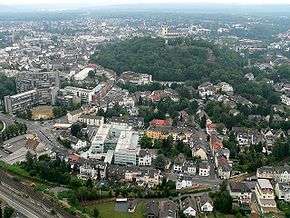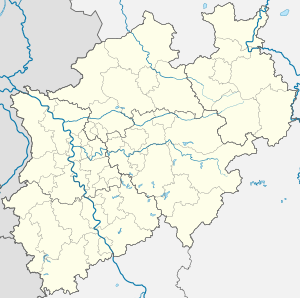Siegburg
Siegburg (i.e. fort on the Sieg river) is a city in the district of Rhein-Sieg-Kreis, in North Rhine-Westphalia, Germany. It is located on the banks of the rivers Sieg and Agger, 10 kilometres from the former seat of West German government Bonn and 26 kilometres from Cologne. The population of the city was 39,192 in the 2013 census.
Siegburg | |
|---|---|
 Aerial view | |
 Coat of arms | |
Location of Siegburg within Rhein-Sieg-Kreis district   | |
 Siegburg  Siegburg | |
| Coordinates: 50°48′5″N 7°12′16″E | |
| Country | Germany |
| State | North Rhine-Westphalia |
| Admin. region | Köln |
| District | Rhein-Sieg-Kreis |
| Subdivisions | 8 |
| Government | |
| • Mayor | Franz Huhn (CDU) |
| Area | |
| • Total | 23.47 km2 (9.06 sq mi) |
| Elevation | 60 m (200 ft) |
| Population (2018-12-31)[1] | |
| • Total | 41,463 |
| • Density | 1,800/km2 (4,600/sq mi) |
| Time zone | CET/CEST (UTC+1/+2) |
| Postal codes | 53721 |
| Dialling codes | 02241 |
| Vehicle registration | SU |
| Website | https://www.siegburg.de/ |
Geography
Siegburg is located approximately 8 kilometres east of the river Rhine, at the confluence where the Agger joins the Sieg, in the southeast corner of the Cologne Lowland. Neighbouring towns include Troisdorf, Lohmar, Sankt Augustin and Hennef. The nearby cities of Cologne and Bonn are easily accessible through good transport links. The highest point of the urban area is 220m above sea level (NHN) in the Braschoß area and the lowest point is just under 54m above sea level at the mouth of the Agger.
History

Archbishop-Elector Anno II of Cologne founded a Benedictine monastery in 1064, known as Michaelsberg Abbey, on top of the hill also called the Michaelsberg. A settlement that arose from that was first mentioned as a city in 1182. Siegburg reached the height of its prosperity in the 15th and 16th century. It is famous for its pottery, especially for the Siegburg pitchers (Siegburger Krüge).
Siegburg has been the county seat of the Rhein-Sieg-Kreis since 1816.
Siegburg's synagogue was destroyed on Kristallnacht, signaling the demise of its Jewish community.
Transport
Siegburg/Bonn station is a railway station on the Cologne-Frankfurt high-speed railway and the Sieg Railway. The name of the station derives from it having been rebuilt for the high-speed line in order to serve Bonn. It is connected to Bonn by the Siegburg line of the Bonn Stadtbahn every 10 or 15 minutes. The station is located in the network area of the Verkehrsverbund Rhein-Sieg (Rhine-Sieg Transport Association, VRS) public transit authority.
International relations
Twin towns – sister cities
Siegburg is twinned with:[2]





Notable residents
- Engelbert Humperdinck (1854–1921), German composer, of Hänsel und Gretel
- Joseph Mohr (1834–1892), author of the hymn "Ein Haus voll Glorie schauet"
- Liselotte Hammes (born 1933), operatic soprano and academic voice teacher
- Wolfgang Overath (born 1943), former Germany national football team player and a member of the team which won the 1974 FIFA World Cup
- Catharina Felser (born 1982), racing-car driver
References
- "Bevölkerung der Gemeinden Nordrhein-Westfalens am 31. Dezember 2018" (in German). Landesbetrieb Information und Technik NRW. Retrieved 10 July 2019.
- "Städtepartnerschaften". siegburg.de (in German). Siegburg. Retrieved 2019-11-28.
External links
- Official website


| Wikimedia Commons has media related to Siegburg. |